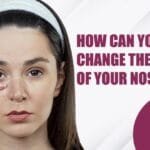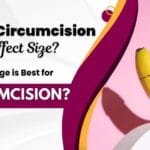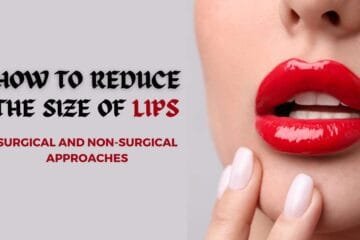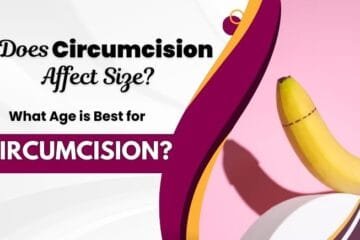Rhinoplasty reshapes the nose through a highly personalized surgical procedure tailored to individual goals. You can also check out our detailed guide on what rhinoplasty is to understand the basics before exploring the procedures. It’s not just about changing the appearance of the nose—it can also improve breathing, repair deformities, or restore symmetry after trauma.
Some people want a sharper tip. Others may need to reduce the size, remove a hump, fix a deviated septum, or correct a crooked nose. Each case is different, and so is the surgical plan.
Let’s explore what surgeons actually do during rhinoplasty in detail. You can also explore our full range of rhinoplasty surgery in Delhi.
Surgeons commonly perform the following procedures during rhinoplasty:
- Tip Plasty
- Alarplasty
- Dorsal Augmentation
- Humpectomy
- Osteotomy
1. Tip Plasty (Nasal Tip Refinement)
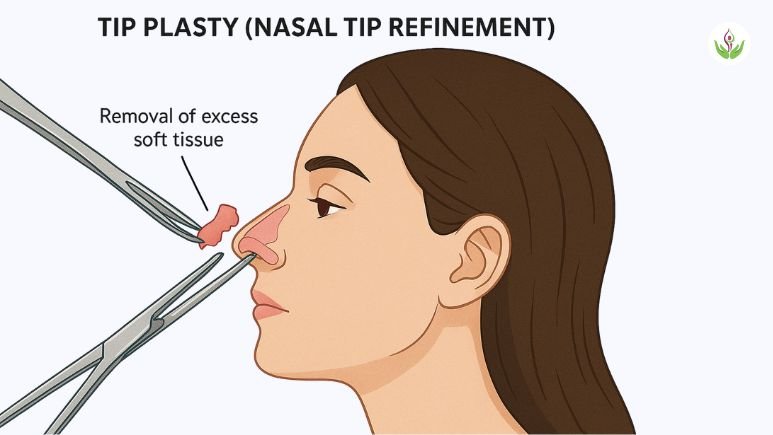
Tip plasty enhances the aesthetic appearance of the nose by improving the shape of the nasal tip. This plastic surgery focuses only on the tip of the nose and does not involve the bridge, roof, cartilage, or nasal bones.
People having a fat nose, or simply a fat tip, requires corrections to elevate the nasal tip so that it looks raised through a proper angle.
Overview:
The nasal tip is one of the most noticeable parts of your nose. For many individuals, the tip might look too round, bulbous, droopy, or thick. Nasal tip refinement aims to give it a more defined and elegant shape.
What’s done:
- Removal of excess fat and soft tissue around the tip.
- Reshaping or narrowing the lower lateral cartilages (cartilage that forms the tip).
- Using fine sutures to create a sharper, symmetrical tip.
- The procedure may include adding cartilage grafts to provide additional support or projection.
Why it’s done:
To enhance the nasal tip’s definition and improve overall nose harmony.
Benefits of Tip Plasty
- Giving definition and a proper structure.
- Enhancing the overall look and feel of the nose and face.
- A surgical procedure that is short and not extensive by any means.
Quick Summary:
Tip refinement sharpens and balances the nasal tip to match your face.
2. Alarplasty (Nostril Reduction)
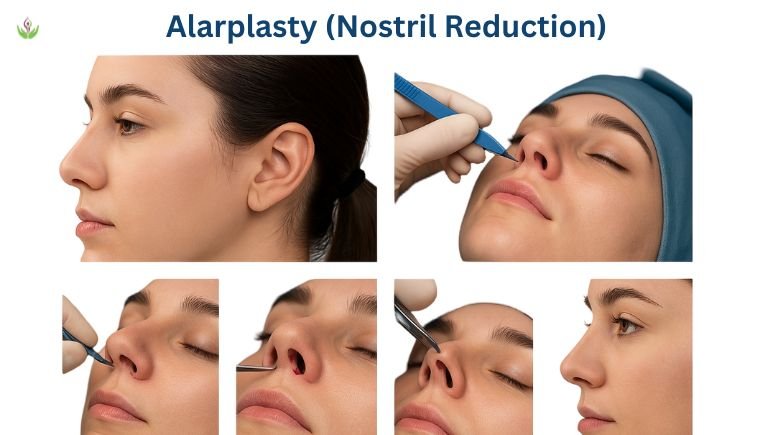
Alarplasty helps people with wide nostrils achieve a more balanced look. In this procedure, the surgeon removes a small wedge of tissue from the sides of the nostrils. The base of the wedge sits near the nostril rims, and the pointed end reaches toward the cheek groove. The amount of tissue removed depends on how wide the nostrils are, with the goal of creating a narrower, more refined shape.
After completing the procedure, the surgeon sutures the open area using either a Weir incision or an incision inside the nose.
Overview:
If the nostrils appear wide or flare out, especially when smiling, alarplasty can help. This procedure focuses on narrowing the nostril base.
What’s done:
- Removal of a wedge-shaped section of tissue at the nostril base.
- Incisions are placed either inside the nostril or at the outer base (Weir technique).
- Precise suturing to reduce width while maintaining symmetry.
Why it’s done:
To reduce nostril flaring and create a more balanced facial appearance.
Benefits of Alarplasty
- Immediate visibility of results.
- Smaller nose or nostrils.
- Symmetrical nose structure.
- Balanced face.
Quick Summary:
Alarplasty makes the nostrils smaller and more proportionate to the nose.
3. Osteotomy (Nasal Bone Repositioning)

Nasal osteotomy helps remove a prominent nasal dorsum or hump and narrows a wide nasal base. It also corrects an open roof deformity that can appear after dorsal hump removal. An osteotomy in rhinoplasty can also widen a narrow pyramid or straighten a deviated septum.
Overview:
People often undergo an osteotomy when the upper part of the nose looks too wide or appears crooked. It’s also common after hump removal.
What’s done:
- Controlled cuts are made in the nasal bones.
- Bones are moved inward to narrow the nose.
- Used to straighten a deviated nose or reshape after trauma.
- Helps close the gap left after removing a dorsal hump.
Why it’s done:
To correct nasal bone structure, restore alignment, and narrow a wide bridge.
Key Benefits:
- Corrects a wide or broad nasal bridge.
- Realigns the nose after trauma or previous surgeries.
- Removes an open roof deformity after hump removal.
- Straightens a deviated septum to improve facial symmetry.
Quick Summary:
Osteotomy reshapes the nose bones for better structure and symmetry.
4. Dorsal Augmentation (Raising a Flat Nose Bridge)

Overview:
If the bridge of your nose is flat or low, dorsal augmentation can add height and definition. People commonly request this in ethnic rhinoplasty to enhance their natural features while maintaining identity.
What’s done:
- Cartilage is taken from the septum, ear, or rib.
- The cartilage is shaped and placed along the nasal bridge.
- Silicone or synthetic implants may be used in some cases.
- Raises the bridge and enhances the nasal profile.
Why it’s done:
To add projection and create a more balanced, refined appearance.
Key Benefits:
- Adds height to a flat or low nasal bridge.
- Improves the side profile and facial harmony.
- Restores volume lost from trauma or previous surgery.
- Offers long-lasting structural improvement.
Quick Summary:
Dorsal augmentation lifts a flat bridge, enhancing the side profile of the nose.
5. Hump Removal (Humpectomy)
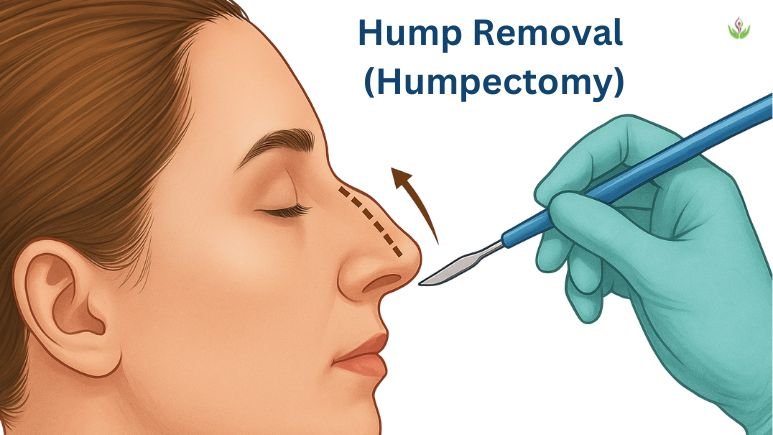
Overview:
A dorsal hump is a bump on the bridge of the nose. It can be made of bone, cartilage, or both. Removing this hump dramatically changes the nose’s shape, especially in profile view.
What’s done:
- The hump is shaved or removed using precise tools.
- Bone edges are smoothed out for a clean finish.
- An osteotomy may follow to bring the nasal bones together.
Why it’s done:
To eliminate the bump and achieve a smoother nasal bridge.
Key Benefits:
- Eliminates bumps that affect the nose’s profile.
- Creates a straighter and more elegant nasal bridge.
- Enhances overall facial symmetry.
- Boosts confidence with a refined appearance.
Quick Summary:
Hump removal creates a cleaner, more aesthetically pleasing nose profile.
6. Cartilage Grafting (Structure & Support)
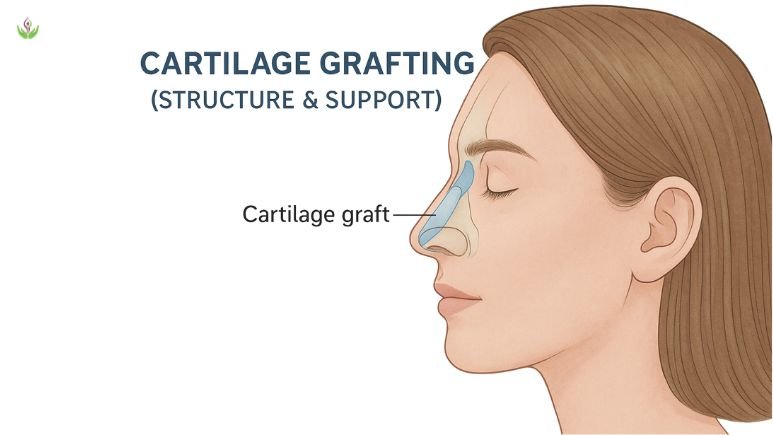
Overview:
Some noses lack the internal structure to hold their shape. Cartilage grafts can rebuild, strengthen, or support areas of collapse.
What’s done:
- Cartilage is harvested from the septum, ear, or rib.
- Grafts are shaped and placed where needed (tip, sides, or bridge).
- Used to add projection, restore symmetry, or reinforce weak spots.
Why it’s done:
To support and shape the nose when natural cartilage is insufficient.
Key Benefits:
- Strengthens weak or collapsed nasal areas.
- Improves nose shape and contour.
- Prevents long-term structural problems.
- Supports other rhinoplasty techniques for better outcomes.
Quick Summary:
Cartilage grafting adds structure and stability for long-term results.
7. Septoplasty (Fixing a Deviated Septum)

Overview:
A deviated septum is a common issue that can block airflow and affect breathing. Many patients don’t realize they have it until it causes symptoms.
What’s done:
- The cartilage wall between the nostrils is straightened.
- Obstructions like spurs or bends are removed.
- The septum may also be used for grafting during cosmetic reshaping.
Why it’s done:
To improve breathing and correct internal nasal structure.
Key Benefits:
- Improves airflow and breathing function.
- Reduces symptoms like snoring and nasal congestion.
- Provides internal support for structural rhinoplasty.
- Enhances overall nasal alignment and comfort.
Quick Summary:
Septoplasty improves airflow and internal balance in the nose. You can also learn more about our septoplasty surgery in Delhi.
🧬 Types of Rhinoplasty Based on Goals
Overview:
Each rhinoplasty is performed with a specific goal in mind. Knowing the type can help you set clear expectations.
Types include:
- Cosmetic Rhinoplasty: Focuses on aesthetics.
- Functional Rhinoplasty: Focuses on breathing and nasal function.
- Reconstructive Rhinoplasty: Repairs trauma or birth defects.
- Revision Rhinoplasty: Corrects unsatisfactory previous surgeries.
- Ethnic Rhinoplasty: Enhances features while respecting cultural identity.
Quick Summary:
Your rhinoplasty plan should match your personal, cultural, and medical goals.
📆 Healing & Recovery Timeline
Overview:
Rhinoplasty recovery is a gradual journey. You may see initial results within a few weeks, but full healing can take up to a year.
Timeline:
- Week 1-2: Swelling and bruising begin to subside.
- Week 3-4: Return to light activities and work.
- Months 2-3: Nose begins to settle into its new shape.
- Months 6-12: Final definition and contour become visible.
Tips:
- Avoid glasses and sleeping on your face.
- Follow your surgeon’s post-op instructions.
- Stay hydrated and be patient with the process.
Emotional Note:
It’s normal to feel emotional or self-conscious during healing. Staying connected with your surgeon can help ease the journey.
Quick Summary:
Healing takes time, but the results are worth the patience and care.
Choosing the Right Rhinoplasty Surgeon
Overview:
The outcome of your rhinoplasty depends heavily on who performs it. The right surgeon understands both aesthetics and function.
What to look for:
- Board certification in plastic or ENT surgery.
- Specialization in rhinoplasty with proven results.
- Before and after photos of previous patients.
- Clear communication and honest feedback.
- Option for second opinions or 3D simulations.
Quick Summary:
Choose a skilled, experienced surgeon who aligns with your vision and values. Learn more about making the right decision with our guide on how to choose a rhinoplasty surgeon in Delhi.
🗣 Final Thoughts
Rhinoplasty is more than just a cosmetic procedure—it can reshape your appearance, improve breathing, and boost self-confidence. Every nose is different, so every rhinoplasty plan should be too.
Quick Wrap-Up:
Take your time to research, ask questions, and partner with the right expert. With proper planning and expectations, rhinoplasty can offer beautiful, lasting results.
FAQs:
Most patients report mild to moderate discomfort after surgery. Pain is usually well managed with medication.
Typically, the surgery lasts 2 to 3 hours, depending on the complexity.
Closed rhinoplasty leaves no visible scars. Open rhinoplasty may leave a small scar under the nose, which usually fades over time.
Most people return to work or light activities within 7 to 10 days after surgery.
Yes, the results are long-lasting. However, minor changes may occur as you age.
Yes, functional rhinoplasty or septoplasty can correct issues like a deviated septum to improve breathing.
When performed by a qualified and experienced surgeon, rhinoplasty is considered a safe and effective procedure.
Generally, rhinoplasty is performed after facial growth is complete—around age 15 for girls and 17 for boys.



